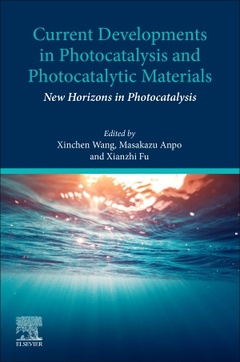Current Developments in Photocatalysis and Photocatalytic Materials New Horizons in Photocatalysis
Coordonnateurs : Wang Xinchen, Anpo Masakazu, Fu Xianzhi

2. Rutile TiO2-based New Photocatalysts for Visible-light Water Oxidation
3. Factors Affecting Photocatalytic Activity of TiO2
4. Controllable Synthesis of TiO2: Toward an Efficient Photocatalyst
5. TiO2-based Photocatalytic Conversion Processes: Insights from In Situ Infrared Spectroscopy
6. Photoreduction of CO2 on non-TiO2 Based Metal Oxides
7. Titania Based Photocatalyst for Dynamic Degradation of VOCs
8. Solvothermal Alcoholysis Preparation of TiO2 with Tailored Structures and Enhanced Activity in Environmental and Energy Photocatalysis
9. TiO2 Polymorphs for Hydrogen Photoproduction
10. Progress in Fundamental Studies and Practical Applications of SrTiO3 Photocatalysts to Overall Water Splitting
11. Environmental Friendly Synthesis of High Efficient Composite Type Photocatalysts
12. Photocatalytic Conversion of CO2 by H2O over Heterogeneous Photocatalysts
13. Seizing Solar Hydrogen from Water Promoted by Magic Spin Transporting, Chiral-induced Spin State-selective Filtering, and Upconversion
14. Recent Advances in the Development of Photocatalytic NOx Abatement
15. ZnO Nanomaterials: Strategies for Improvement of Photocatalytic and Photoelectrochemical Activities
16. BiVO4, a Ternary Metal Oxide as an Efficient Photocatalytic Material
17. Photocatalytic and Photo-Fenton-catalytic Degradation of Organic Pollutants by BiFO3 (BFO) and BiVO4 (BVO) Photocatalysts under Visible-light Irradiation
18. Preparation and Photocatalytic Performance of Monolayer Inorganic Oxide Nanosheets
19. TiO2/carbon Composite Nanomaterials for Photocatalysis
20. The Design and Development of MOF Photocatalysts and Their Applications for Water Splitting Reaction
21. Light-induced Organic Transformations over some MOF Materials
22. Mesoporous Silica supported Ag based-Plasmonic Photocatalysts
23. Development of Metal Sulfide-based Photocatalysts for Hydrogen Evolution Under Visible Light
24. Photocatalysis with Octahedral Sulphides
25. Reduced Graphene Oxide (rGO) Supported on Metal Oxides Catalysts for Photocatalytic Reactions
26. Current Development of Graphitic Carbon Nitride Photocatalysts as One of Organic Semiconducting Photocatalytic Materials
27. Carbon Nitride as Photocatalyst in Organic Selective Transformations
28. Heterogeneous Photocatalysis by Organic Materials: From Fundamental to Applications
29. Photocatalytic Performance of Hexagonal Boron Carbon Nitride Nanomaterials
30. Theoretical Studies of Two-dimensional Photocatalyst Materials
31. Atomically Scale Design of Van der Waals Heterostructures as Photocatalysts
Prof. Masakazu Anpo is presently a Special Honor Professor & International Advisor of the State Key Laboratory of Photocatalysis on Energy and Environment, Fuzhou University. He worked for 40 years at Osaka Prefecture University and served as Dean, Vice President & Executive Director for last 10 years and is now a Professor Emeritus. He is a pioneer in the research of photochemical reactions on solid surfaces, design of visible-light-responsive TiO2 photocatalysts, and single-site heterogeneous photocatalysts constructed within zeolites. He is the editor-in-chief of Res. Chem. Intermed. (Springer). He has published more than 100 books and 500 original peer-reviewed papers. He is a member of Academia Europaea and Science Council of Japan.
Prof. Xianzhi Fu received his Ph.D. degree in Physical Chemistry from Peking University, China, in 1991. He did postdoctoral research on catalysis and photocatalysis at Peking University and University of Wisconsin-Madison, respectively. He joined Fuzhou University in 1997 where he was promoted to a full professor in 1998. Currently, he is the President of Fuzhou University. His research interests are mainly focused on Photocatalysis. He is the author or co-author of more than 300 peer-reviewed scientific publi
- Reviews developments in both organic- and inorganic-based materials for use in photocatalysis
- Presents the fundamental chemistry and activity of a broad range of key photocatalytic materials, including both typical and novel materials
- Highlights the role photocatalytic materials can play in sustainable applications
Date de parution : 11-2019
Ouvrage de 566 p.
15x22.8 cm
Thème de Current Developments in Photocatalysis and... :
Mots-clés :
6-Coordinated sulfides; Ag deposition; Artificial photosynthesis; Atmospheric controlled pulsed laser deposition (AC-PLD)Composite-type photocatalyst; Bacteria; Band gap engineering; BiFeO3BiVO4Organic pollutants; BiVO4DFT calculations; C3N4/TiO2Carbon dots; Carbon dioxide; Carbon nitride; C-C formation; Charge-carrier mediator; Chiral-induced spin selectivity (CISS) effect; Clean energy; CO2 reduction; Conversion; Coupling reactions; Degradation of organic pollutants; Degradation; Density funct
